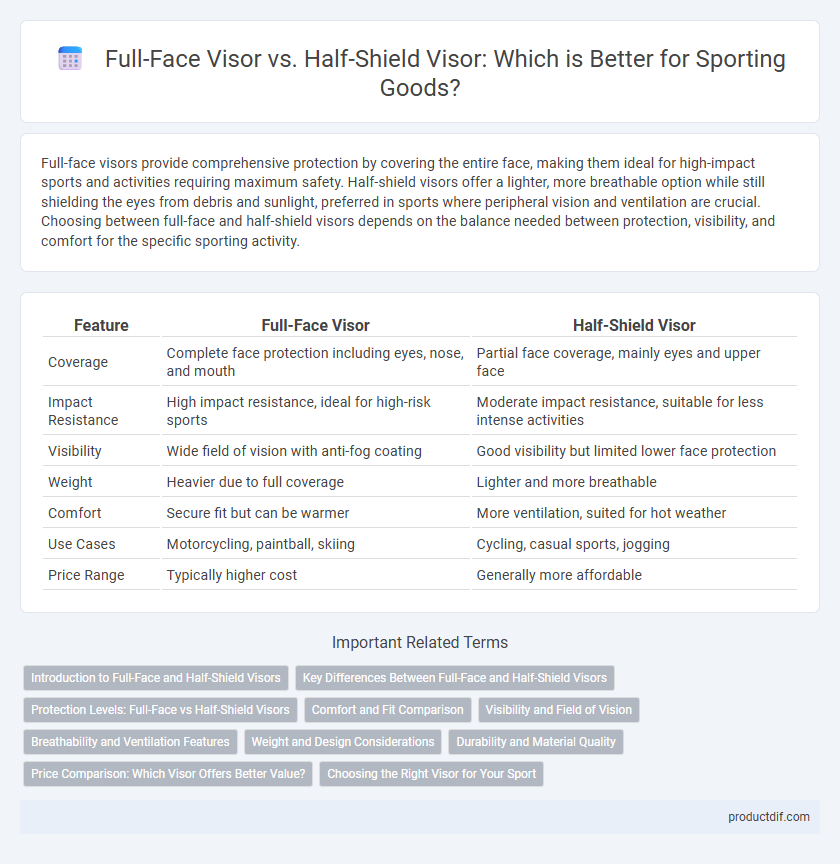Full-face visors provide comprehensive protection by covering the entire face, making them ideal for high-impact sports and activities requiring maximum safety. Half-shield visors offer a lighter, more breathable option while still shielding the eyes from debris and sunlight, preferred in sports where peripheral vision and ventilation are crucial. Choosing between full-face and half-shield visors depends on the balance needed between protection, visibility, and comfort for the specific sporting activity.
Table of Comparison
| Feature | Full-Face Visor | Half-Shield Visor |
|---|---|---|
| Coverage | Complete face protection including eyes, nose, and mouth | Partial face coverage, mainly eyes and upper face |
| Impact Resistance | High impact resistance, ideal for high-risk sports | Moderate impact resistance, suitable for less intense activities |
| Visibility | Wide field of vision with anti-fog coating | Good visibility but limited lower face protection |
| Weight | Heavier due to full coverage | Lighter and more breathable |
| Comfort | Secure fit but can be warmer | More ventilation, suited for hot weather |
| Use Cases | Motorcycling, paintball, skiing | Cycling, casual sports, jogging |
| Price Range | Typically higher cost | Generally more affordable |
Introduction to Full-Face and Half-Shield Visors
Full-face visors provide extensive facial protection, covering the entire face to guard against debris, impacts, and weather conditions, making them ideal for high-contact sports and activities. Half-shield visors cover only the upper part of the face, mainly the eyes, offering improved airflow and lighter weight but less overall coverage. Choosing between a full-face and half-shield visor depends on the balance between protection needs and comfort preferences during sporting activities.
Key Differences Between Full-Face and Half-Shield Visors
Full-face visors provide complete coverage, protecting the entire face from debris, wind, and UV rays, while half-shield visors cover only the eyes and upper face area, offering limited protection. Full-face visors often feature anti-fog and anti-scratch coatings, enhancing durability and visibility in diverse weather conditions, unlike half-shield visors which prioritize lightweight design and ventilation. Choosing between full-face and half-shield visors depends on the sport's safety requirements, environmental exposure, and user preference for visibility versus protection.
Protection Levels: Full-Face vs Half-Shield Visors
Full-face visors provide comprehensive protection by covering the entire face, minimizing the risk of injury from debris, impacts, and harsh weather conditions. Half-shield visors offer partial coverage, primarily protecting the eyes while leaving the lower face exposed, which may reduce overall safety in high-risk environments. Choosing between full-face and half-shield visors depends on the specific level of protection required for activities like cycling, motorcycling, or other sporting events.
Comfort and Fit Comparison
Full-face visors offer comprehensive protection with a secure fit that reduces wind resistance, enhancing overall comfort during prolonged sporting activities. Half-shield visors provide increased airflow and lighter weight, making them ideal for athletes prioritizing breathability and minimal obstruction. Selecting between the two depends on balancing maximum coverage with ventilation needs for optimal performance and comfort.
Visibility and Field of Vision
Full-face visors provide comprehensive protection but can slightly limit peripheral visibility due to their enclosed design, potentially affecting the field of vision in fast-paced sports. Half-shield visors offer a wider field of vision and improved airflow, enhancing situational awareness and visual clarity for athletes. Choosing between full-face and half-shield visors depends on balancing maximum protection with optimal visibility requirements for the specific sport.
Breathability and Ventilation Features
Full-face visors offer comprehensive protection but often limit breathability due to their enclosed design, which can trap heat and moisture inside the helmet. Half-shield visors provide improved ventilation by exposing more of the face, allowing air to circulate and reducing fogging and sweat buildup during physical activity. Advanced materials and strategically placed vents in some full-face models help enhance airflow, yet half-shield visors remain superior for breathability in high-intensity sports.
Weight and Design Considerations
Full-face visors typically weigh more than half-shield visors due to their extended coverage, offering enhanced protection around the chin and jaw. The bulkier design of full-face visors increases wind resistance, which can impact performance in fast-paced sports. Half-shield visors provide a lighter, more streamlined option, improving ventilation and reducing fatigue without compromising essential eye protection.
Durability and Material Quality
Full-face visors offer superior durability due to their reinforced polycarbonate construction, providing enhanced impact resistance and long-lasting protection in high-intensity sports. Half-shield visors, typically made from lighter, thinner materials, prioritize visibility and ventilation but may sacrifice some structural strength compared to full-face options. Material quality in full-face visors often includes anti-scratch and UV-resistant coatings, ensuring prolonged clarity and reliability under rigorous conditions.
Price Comparison: Which Visor Offers Better Value?
Full-face visors generally come at a higher price point due to their comprehensive protection and durable materials, making them ideal for high-impact sports and extreme conditions. Half-shield visors are more affordable, providing adequate visibility and ventilation for moderate activities while sacrificing some protection. When comparing price versus protection value, full-face visors offer better long-term investment for serious athletes, whereas half-shield visors suit budget-conscious consumers prioritizing comfort and cost.
Choosing the Right Visor for Your Sport
Full-face visors provide comprehensive protection against debris, impacts, and weather conditions, making them ideal for high-contact sports like football and lacrosse. Half-shield visors offer enhanced visibility and ventilation, preferred in sports such as hockey where peripheral vision and airflow are crucial. Selecting the right visor depends on the specific protective needs and performance demands of your sport.
Full-face visor vs Half-shield visor Infographic

 productdif.com
productdif.com